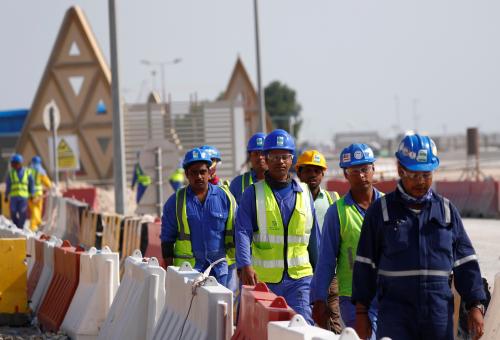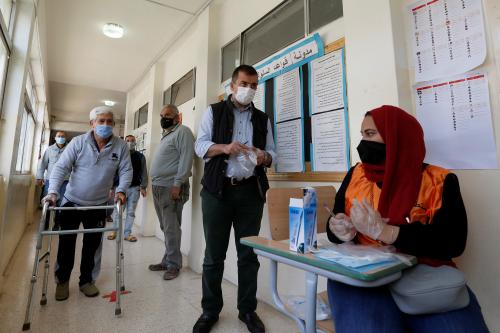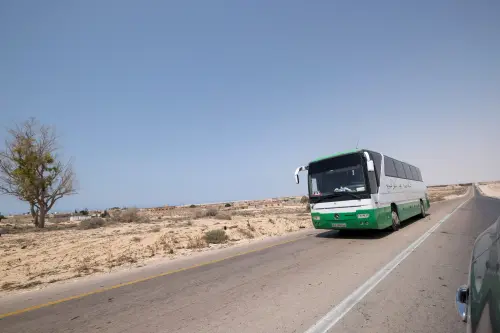Content from the Brookings Doha Center is now archived. In September 2021, after 14 years of impactful partnership, Brookings and the Brookings Doha Center announced that they were ending their affiliation. The Brookings Doha Center is now the Middle East Council on Global Affairs, a separate public policy institution based in Qatar.
Syria’s rebels are making sweeping gains, as foreign powers up support and work with Islamist fighters. But the regime isn’t about to go down without a fight.
After roughly two years of being on the defensive, Syria’s rebels are making dramatic gains in the north of the country. In the span of six weeks, coalitions of insurgent fighters captured the city of Idlib and won a series of key strategic victories elsewhere in the governorate. In the face of the opposition, the Syrian Army and its supporting militias appear at their weakest point since early 2013.
However, while much of the subsequent commentary proclaimed this as the beginning of the end for President Bashar al-Assad’s regime, we are still a long way from that. In fact, the regime reacted to its dramatic losses in the north by carrying out hundreds of air strikes, barrel bombings, and chlorine attacks in rural Idlib, Hama, and Aleppo. Regime ground offensives were launched in eastern Damascus, in areas of Homs, and in the mountains around Zabadani near the Lebanese border. Meanwhile, a major joint regime-Hezbollah offensive in the Qalamoun mountains now also looks imminent.
So what is happening in Syria? Recent events have clearly tipped the psychological scales back into the opposition’s favor: Losses in Idlib and the southern governorate of Deraa have placed great pressure on Assad, whose severe manpower shortages are becoming more evident by the day. Frustration, disaffection and even incidences of protest are rising across Assad’s most ardent areas of support on Syria’s coast — some of which are now under direct attack. Hezbollah is stretched thin and even Iranian forces have begun withdrawing to the areas of Syria deemed to be the most important for regime survival.
The regime is no longer militarily capable of launching definitively successful operations outside of its most valuable territories, while its capacity for defense against concerted attack now appears questionable at best. It also looks diplomatically weaker, as Russia appears no longer wedded to the Assad regime’s long-term survival and is now more open to the idea of a managed transition that would ensure the best chances of post-regime stability. Meanwhile, Iran’s apparent rapprochement with the United States and its expected involvement in talks in Geneva convened by UN Special Envoy Staffan de Mistura may open the door for, at the very least, discussions of a negotiated solution in Syria.
However, diplomacy alone will be unlikely to provide a path out of Syria’s conflict. Even as a broad swathe of the international community talks behind closed doors about launching a major new diplomatic initiative on Syria, it will ultimately be military pressure inside Syria that will determine whether such an initiative has any chance of success.
* * *
The recent opposition victories displayed in Idlib revealed far greater strategic planning than had been evident before. The rebels’ recent successes in Idlib represented nothing less than an eight-month grand strategy for the wholesale capture of the governorate, and its transformation into the opposition’s core area of control.
The offensive on Idlib city, for instance, was launched on March 24 — but had in fact been planned since the winter of 2014, and was itself inextricably linked to the successful and long-planned offensive that captured the Wadi al-Deif and Al-Hamadiyeh military bases outside the town of Marat al-Numan in mid-December 2014. Following the capture of Idlib city, the rebels then swiftly launched the offensive on the western Idlib town of Jisr al-Shughour, led primarily by opposition forces from the neighboring Latakia governorate, while forces from the Idlib city operation spread outwards to core regime positions in al-Mastouma, al-Qarmeed, and Ariha.
Considering the immense complexity of the northern Syrian insurgency, the opposition’s gains in Idlib therefore represent an impressive feat. But planning alone did not ensure the victories: The operations also displayed a far improved level of coordination between rival factions, spanning from U.S.-backed Free Syrian Army (FSA) brigades, to moderate and conservative Syrian Islamists, to al Qaeda affiliate Jabhat al-Nusra and several independent jihadist factions. Although this went largely unacknowledged by the groups involved — and while media coverage broadly portrayed the Idlib offensives as “jihadist” or al Qaeda-led — the reality on the ground was that the recent offensive brought together many groups holding very different ideologies.
FSA groups only played a minor role in the advance into Idlib city itself, but played a crucial support role in preventing regime reinforcements from going to the city’s defense. Moreover, their role in Jisr al-Shughour’s capture was more significant and they are similarly active elsewhere to this day.
The involvement of FSA groups, in fact, reveals how the factions’ backers have changed their tune regarding coordination with Islamists. Several commanders involved in leading recent Idlib operations confirmed to this author that the U.S.-led operations room in southern Turkey, which coordinates the provision of lethal and non-lethal support to vetted opposition groups, was instrumental in facilitating their involvement in the operation from early April onwards. That operations room — along with another in Jordan, which covers Syria’s south — also appears to have dramatically increased its level of assistance and provision of intelligence to vetted groups in recent weeks.
Whereas these multinational operations rooms have previously demanded that recipients of military assistance cease direct coordination with groups like Jabhat al-Nusra, recent dynamics in Idlib appear to have demonstrated something different. Not only were weapons shipments increased to the so-called “vetted groups,” but the operations room specifically encouraged a closer cooperation with Islamists commanding frontline operations.
The most likely explanation for such a move is pressure from the newly emboldened regional alliance comprising Turkey, Saudi Arabia, and Qatar. The United States also is looking for ways to prove its continued alignment with its traditional Sunni Gulf allies, amid the broader context of its rapprochement with Iran.
The rebels’ newfound coordination was also certainly bolstered by the campaign’s reliance on Idlibi commanders. Ahmad al-Ulwan, Yusuf Qutband Hossam Abu Bakr are all local rebel commanders who played a prominent role the capture of Idlib city; meanwhile, the principal commander at Jisr al-Shughour was Eyad Sha’ar — an Ahrar al-Sham commander who enjoys sky-high prestige within the opposition at large. Sha’ar hails from Jisr al-Shugour, but left Syria with his parents 37 years ago during the beginnings of the Muslim Brotherhood-led uprising in Syria. Despite his status as an Afghan veteran and a founding member of Ahrar al-Sham, his return to his hometown for the first time since his departure was celebrated across the opposition spectrum.
Local connections have proven valuable unifiers in Syria so far — particularly in areas where a provincial identity is particularly strong, like Homs, Idlib, and Aleppo. Although many of the most prominent commanders in recent Idlib operations were Islamists of one kind or another, their roots in the province’s society appears to have discouraged the kind of inter-group and intra-ideological rivalries that have arisen elsewhere in the country. This is not to dismiss the very real differences that exist between, say, Jabhat al-Nusra and the FSA-affiliated 13th Division, but the very fact that they did not appear to negatively affect advances on regime-held territory is a sign that they are a powerful unifying factor.
* * *
International and ideological differences appear to have been pushed aside, at least temporarily, in favor of better ensuring the Syrian opposition’s success on the battlefield. Moreover, the recent offensive revealed a level of military maturity rarely demonstrated by the opposition. The fact that this produced such positive outcomes and shook the regime’s confidence so significantly has been a source of immeasurable opposition confidence. But can it last?
Despite the improved cooperation on the battlefield, Syrians still remain deeply suspicious of Jabhat al-Nusra’s objectives in Syria, and U.S.-backed factions still engage warily with Islamists. Of course, public rhetoric is not always an accurate indicator of battlefield action: In southern Syria, for instance, factions that vowed to distance themselves from extremists like Jabhat al-Nusra in mid-April were seen cooperating with the group in Deraa only days later.
The one factor unifying all parties so far has been a determination to establish efficient and sustainable civil governance in liberated territories. The regime’s massive and indiscriminate bombardment and multiple chemical attacks, however, have made this nearly impossible. Should that dynamic of brutal repression sustain itself, the only foreseeable consequence is that extremists will exploit the vacuum. In other words, al Qaeda wins.
It is for precisely this reason that Turkey has so publicly facilitated thecoming together of Syria’s two largest insurgent groups, Ahrar al-Sham and Jaish al-Islam. With the tacit agreement of Saudi Arabia and its new leadership, Turkey’s strong hand in encouraging Islamist unity in northern Syria is meant not only to produce a more effective front against the regime, but also to bring together a broad Syrian Islamist base to balance against al Qaeda’s continued rise. This by extension will provide an even more solid barrier of defense against the Islamic State, should it some day carry through on its threat to return to northwestern Syria.
Both Ahrar al-Sham and Jaish al-Islam have co-opted additional insurgent factions within their umbrellas in recent weeks, very often incorporating units of far less conservative Islamic outlooks. Most recently, rumors have spread that the Muslim Brotherhood-oriented Faylaq al-Sham will soon merge into Ahrar al-Sham, though Faylaq al-Sham’s leadership has so fardenied the reports. Although a merger of Jaish al-Islam and Ahrar al-Sham still seems a distant prospect, their forces combined represent at least 40,000 fighters — with some recent estimates even suggesting they could amount to as many as 70,000.
* * *
As things stand today, the uptick in U.S. and Saudi-led support for “moderate” FSA factions and Turkey and Qatar-led assistance to Islamists appears to be complementary, rather than done in competition as has been the case in the past. However, many obstacles to this strategy lie on the road ahead — not least the actions of Jabhat al-Nusra, which thus far has demonstrated an impressive knack for manipulating the dynamics of the Syrian opposition to its advantage.
The Islamic State also threatens to derail the opposition’s recent string of successes. Since late 2014, the jihadist group has quietly infiltrated new areas and co-opted local allies to gradually expand its reach. Thus far, this strategy — which it used to great effect after its arrival in Syria in early 2013 — has resulted in hostilities breaking out on multiple occasions across the country, from Deraa and Quneitra in the south, to the capital of Damascus, and the western governorate of Hama. Such an expansionary policy risks re-opening the ideological divides within Syria’s broader opposition that are currently being brushed under the carpet.
Syria’s new dynamics make this a critical time for the international community. The rebels’ newfound sense of unity is a positive development in the fight against the regime — but there still remains no better alternative to cooperating with al Qaeda, and thus facilitating its prominence. If the West wants a better solution, it must broaden and intensify its engagement with Syria’s insurgent groups and considerably expand its provision of assistance to a wider set of acceptable groups. It should also make all necessary efforts to ensure that newly liberated territories in northern Syria benefit from the establishment of representative and civil governance. Preventing the regime’s indiscriminate use of air power is crucial in this respect.
Due to the sheer scale and complexity of the Syrian insurgency, dealing with it effectively is neither easy nor without its risks. However, dealing with it intermittently and with one hand behind your back is a sure way of giving your adversaries opportunities to grow even more dangerous.
This article originally appeared on Foreign Policy.



Commentary
Op-edWhy Assad is losing
May 5, 2015